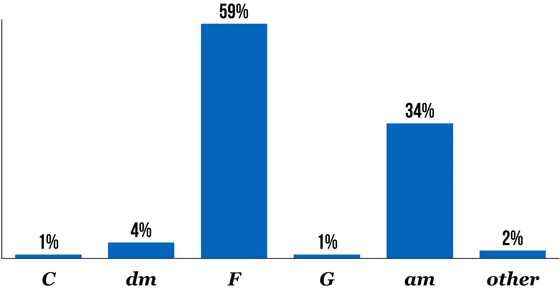What is the 'pattern common to popular songs' that was discovered by analyzing popular songs over 1300 songs?

by rawpixel.com
Many people around the world enjoy listening to music, but attempting to 'analyze statistically' such music may not be very common. To produce the software and books to help you create the song " Hooktheory Dave Carlton who is the writer of" also of analyzing the popular music 1300 songs in order to determine to what function the music, code patterns and use of proceeds We publish the results of examining frequency.
Tabs that show the theory behind songs - Hooktheory
https://www.hooktheory.com/theorytab/
I analyzed the chords of 1300 popular songs for patterns. This is what I found. - The Hooktheory Blog
http://www.hooktheory.com/blog/i-analyzed-the-chords-of-1300-popular-songs-for-patterns-this-is-what-i-found/
Regarding the chord progression of a song, there are many things that are described in an introductory book such as a guitar, but these pieces of information are not the result of actually analyzing popular songs by the public and taking statistics. Carlton acquired 1,300 pieces of song data from the American popular chart " Billboard Hot 100 " from 2010 to 2012 and analyzed the chord progression of popular songs based on the constructed database.
Carlton's point of note is that the analysis focuses on "popular music" based on Billboard's ranking and does not apply to fields such as jazz and classical. Also, in analysis, we collect information on chords and melodies, and we do not analyze information on arrangements and instruments. After mentioning these caveats, Mr. Carlton answers various questions about popular music in the world.

by Thibault Trillet
◆ 1: What is the most popular key ?
Perhaps people are concerned about "What is popular code?" According to Carlton, the code used in the song depends on the key of the song, many songs It is meaningless to figure out the popularity of code alone from the data. So Carlton gathers data on 'popular key' and summarizes it.
The following images are arranged in order of popular keys from popular music ranked in Billboard. First place is C , 2nd place is G , 3rd place is E flat . In general there are tendencies to prefer keys with less sharpness or flatness but the B flat with only 3 flat flat E flat than flat F with only one flat or only 2 flat flat is 4% It seems that it is not necessarily applicable to all keys, because it is used only.

◆ 2: What is the most popular code?
Choosing a popular code based on songs made with various keys is not very meaningful, Carlton says, "By comparing songs made with a single key you can look up popular code "As a substitute for all songs by the key of C, we made it possible to compare directly popular codes.
As a result, the popular code ranked as follows. As expected by Mr. Carlton, it was confirmed that the usage rate of C major was increased when written with the key of C, but the result that the frequency of appearances of G Major and F Major gets higher than that was found out. Next to these three codes Am code boasts popularity, but you can see that usage rate drastically decreases at a stretch afterwards.

Carlton says that he can explain it using music theory about the question "Why am is popular so much, Major A is not popular?" Even though you know music theory Even if not, we say that it is possible to improve our songs based on statistics. Speaking of statistics analyzing popular songs, for example, "When your song is made with the C key, using Major A is not prudent," Carlton says.
In addition, Mr. Carlton said about the guitar code provided in Apple's iOS application " GarageBand ", "Although Bdim is a diatonic code for the C key, it is certainly a D major or E It is not more general than major. "

◆ 3: Of the songs made with the C key, what is the code that comes after E minor?
By using Mr. Carlton's analysis, it is also possible to analyze the correlation of various codes. For any code, it is possible to show a graph of "code frequently following that code", but for example in a song written in C "a code likely to come after E minor" Mr. Carlton exemplifies.
The graphic summarizing the analysis results is the following image. In popular songs made with the C key, almost everything that comes after E minor is almost F major or A minor. There are only 7% of other codes coming.

By statistically analyzing popular music like this, it seems that various interesting facts are found about the chord progression of popular songs.
Related Posts:
in Note, Posted by log1h_ik






